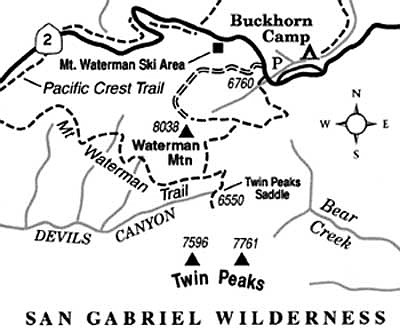 Facebook
Facebook
 X
X
 Instagram
Instagram
 TikTok
TikTok
 Youtube
Youtube
The "top of the world" views from Twin Peaks ridge are among the best in the San Gabriel Mountains. Sometimes in summer (and often in winter) you can look south over a low-lying blanket of fog or smog in the Los Angeles Basin and see Santa Catalina Island floating beyond the hazy dome of the Palos Verdes peninsula. The Santa Ana, Palomar, Santa Rosa, and San Jacinto mountain ranges arc around the horizon from south to east.
June is a perfect month to undertake the strenuous ten-mile trek to Twin Peaks and back. Springtime lingers long at these elevations of between 7000 and 8000 feet, and the air is scented with the fresh fragrance of sun-warmed pines. Be sure to bring along plenty of water, especially if you will be hiking in the heat of the day.
You'll begin hiking on the Mt. Waterman Trail, which starts on the south side of Angeles Crest Highway (Highway 2) about midway through the highway's long and windy course between La Ca�ada and Wrightwood. Park your car at the Buckhorn trailhead, which is located at mile 58.0 according to the highway mileage signs (you'll need to post a National Forest Adventure Pass on your car for the privilege of parking). Cross the highway to reach the start of the trail.
Follow the well-graded foot trail -- not the old road bed that parallels the trail at first -- along a shady slope. After 1.0 mile of easy ascent through gorgeous mixed-conifer forest, you come to a saddle overlooking Bear Creek. The trail turns west, follows a viewful ridge, and then ascends on six long switchbacks to a trail junction, 2.1 miles. The trail to Waterman Mountain's summit goes right; you stay left and eventually zigzag south down to a second junction, 3.5 miles. Make a hard left here and continue descending a more primitive trail to Twin Peak Saddle (6550'), the lowest point on the divide separating upper Devil Canyon from upper Bear Creek.
From Twin Peaks Saddle, the now-sketchy trail contours south to reach a second saddle (6580') at the north base of Twin Peaks ridge. From there, you simply go straight up the slope, dodging boulders and trees, until you arrive on the ridgeline between the two peaks. Climb a short distance east to bag the 7761-foot eastern peak. If you drop a short way down to rock outcrops south and east, just below the summit, you'll have a dizzying view of the secret, upper reaches of Bear Creek's West Fork. Serrated ridges of shattered diorite, a rock-climber's nightmare, seem to tumble into the pit below.
If you are ready for a little more adventure before returning, go ahead and climb the 7596-foot west peak as well. The view south from there is even more vertiginous. Keep an eye out for Nelson bighorn sheep. Hikers signing the registers on both peaks have reported frequent sightings of these shy, elusive creatures.


The "top of the world" views from Twin Peaks ridge are among the best in the San Gabriel Mountains. Sometimes in summer (and often in winter) you can look south over a low-lying blanket of fog or smog in the Los Angeles Basin and see Santa Catalina Island floating beyond the hazy dome of the Palos Verdes peninsula. The Santa Ana, Palomar, Santa Rosa, and San Jacinto mountain ranges arc around the horizon from south to east.
June is a perfect month to undertake the strenuous ten-mile trek to Twin Peaks and back. Springtime lingers long at these elevations of between 7000 and 8000 feet, and the air is scented with the fresh fragrance of sun-warmed pines. Be sure to bring along plenty of water, especially if you will be hiking in the heat of the day.
You'll begin hiking on the Mt. Waterman Trail, which starts on the south side of Angeles Crest Highway (Highway 2) about midway through the highway's long and windy course between La Ca�ada and Wrightwood. Park your car at the Buckhorn trailhead, which is located at mile 58.0 according to the highway mileage signs (you'll need to post a National Forest Adventure Pass on your car for the privilege of parking). Cross the highway to reach the start of the trail.
Follow the well-graded foot trail -- not the old road bed that parallels the trail at first -- along a shady slope. After 1.0 mile of easy ascent through gorgeous mixed-conifer forest, you come to a saddle overlooking Bear Creek. The trail turns west, follows a viewful ridge, and then ascends on six long switchbacks to a trail junction, 2.1 miles. The trail to Waterman Mountain's summit goes right; you stay left and eventually zigzag south down to a second junction, 3.5 miles. Make a hard left here and continue descending a more primitive trail to Twin Peak Saddle (6550'), the lowest point on the divide separating upper Devil Canyon from upper Bear Creek.
From Twin Peaks Saddle, the now-sketchy trail contours south to reach a second saddle (6580') at the north base of Twin Peaks ridge. From there, you simply go straight up the slope, dodging boulders and trees, until you arrive on the ridgeline between the two peaks. Climb a short distance east to bag the 7761-foot eastern peak. If you drop a short way down to rock outcrops south and east, just below the summit, you'll have a dizzying view of the secret, upper reaches of Bear Creek's West Fork. Serrated ridges of shattered diorite, a rock-climber's nightmare, seem to tumble into the pit below.
If you are ready for a little more adventure before returning, go ahead and climb the 7596-foot west peak as well. The view south from there is even more vertiginous. Keep an eye out for Nelson bighorn sheep. Hikers signing the registers on both peaks have reported frequent sightings of these shy, elusive creatures.
